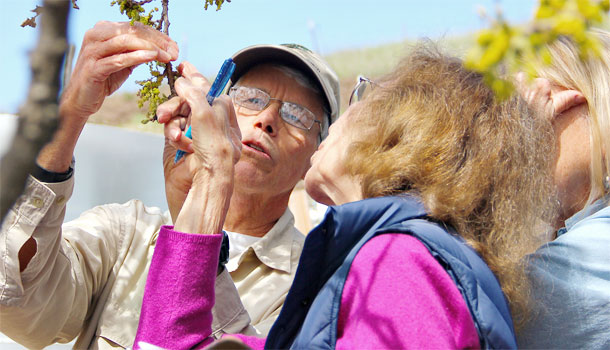
Studying the seasons: how climate change affects natural communities
Wednesday 19 December 2012
UC Santa Barbara researchers have launched the California Phenology Project. Scientists, docents, staff, teachers and citizen researchers will track the life stages of selected plant species at eight UC natural reserves.
Nature celebrates the seasons with unmistakable changes. During the spring In California, rhododendrons add bursts of pink to coastal forests, bare buckeye branches grow leaf buds and great egrets gather to nest in tall trees. In autumn, quaking aspens turn from green to gold, toyon produce bundles of berrylike fruits and snow geese collect by the hundreds of thousands in Sacramento Valley wetlands.
Each of these events is influenced by climate. Factors such as temperature, rainfall and rates of snowmelt help dictate not only when plants set seed and butterflies lay eggs, but also how intense the wildflower bloom will be.
Nowadays, observing nature’s seasonal events is a serious science. Called phenology, the study of recurring biological changes and their responses to the environment can answer a host of pressing ecological questions. Chief among these: How is climate change affecting natural communities?
The answers have major implications for both nature and people. Warblers that migrate earlier than insects hatch could starve. Rodents that require colder conditions could shift their ranges upslope. Flowers that bloom before bees emerge might never get pollinated. Changing weather patterns could accelerate crop planting and harvesting, as well as allergy and fire seasons. Conserving particular species or communities in a changing climate will require shifts in land management or restoration practices.
To keep tabs on natural schedules in California, researchers at UC Santa Barbara have launched the California Phenology Project. Led by professor of ecology and evolutionary biology Susan Mazer, graduate student Brian Haggerty, and postdoctoral fellow Elizabeth Mathews, the project is observing plants at eight UC Natural Reserves and seven national parks, totaling more than 100 monitoring sites.
Scientists, docents, staff, teachers and other citizen researchers are being trained to track the life stages of several selected plant species found at each site. Thirty plant species are being targeted statewide. The data are then submitted online to the USA National Phenology Network, which makes phenology data from across the country available for education and analysis. The California project already has submitted more than 150,000 observations to the national database since 2011.
The state project began in 2010, when the National Park Service funded a pilot monitoring program in seven parks across the state. The UC Santa Barbara scientists developed protocols, selected target species, developed plant identification materials and trained people to document events such as flower maturity and fruit set.
The project expanded to the UC Natural Reserve System in 2011 with a $32,000 Research Opportunity Award from Steven Beckwith, UC vice president for research. Together with $8,000 in matching funds from the UC Santa Barbara Office of Research, this funding provided training and coordination efforts at eight UC NRS sites.
“The UC Office of the President funding has been absolutely critical to this project; without it we would not be coordinating the first multi-reserve science and education project in the NRS’s 47-year history,” Haggerty said.
The project was a plus for the NRS long before plant monitoring began. In order to pinpoint the plant species found at each reserve, and decide which to monitor, the scientists had to compile a plant list for the entire NRS. The resulting NRS flora was the first time such a list was assembled in one place.
The NRS arm of the study is well underway. For example, Haggerty has trained 40 Sedgwick Reserve docents in phenological monitoring, ten of whom have committed to dedicated weekly monitoring. At Valentine Camp and Sierra Nevada Aquatic Research Laboratory, volunteers have already been collecting data throughout the summer.
“Reserve managers are using this project as a platform to engage their local communities of scientists, educators, volunteers, and the public, helping to raise awareness of, and participation with, the UC NRS,” Haggerty said. For example, reserve director Vincent Vogeli of Hastings Natural History Reservation is using project as a core piece of his new docent program.
Haggerty and colleagues are spreading the word about California phenology monitoring as broadly as they can. To date, they have trained more than 600 workshop participants, written a book chapter and lesson plans, conducted a UC Extension class for high school teachers, and submitted an article for the January 2013 issue of Madroño, the journal of the California Botanical Society
In December, they presented lectures and phenology field workshops in southern California so that citizen scientists could learn to contribute to the study of climate change from their own back yards.
Photo at top of page by Brian Haggerty